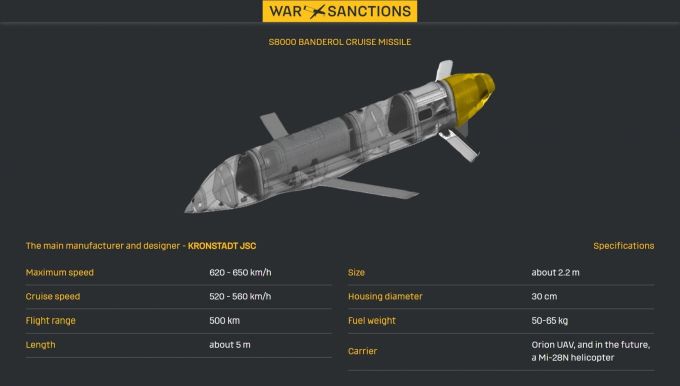The S8000 “Banderol” is a new Russian guided missile that has been the subject of detailed information from the Ukrainian military intelligence agency GUR (Holovne upravlinnya rozvidky). It is an innovative approach by Moscow to the production of precise, low-cost, long-range weapons, as indicated by GUR’s findings, and it is substantially different from the types of Russian weaponry that were previously known. A diverse array of foreign components, particularly those from the United States, China, Japan, South Korea, and Switzerland, are used in the missile. The Banderol is designed to be highly maneuverable and optimized for drone deployments while still maintaining a characteristic flight trajectory, in contrast to conventional cruise missiles.
The Russian company Kronstadt, which has been under sanctions by numerous Western nations since 2022, is the developer of the missile. Kronstadt is best known for its production of Orion drones, which are the main platform from which the Banderol missile is launched. Russia is presently in the process of integrating the missile with Mi-28N attack helicopters, which will significantly enhance its deployment capabilities. The Banderol has been used on numerous occasions in southern Ukraine, as indicated by the Defense Express website. A few specimens were recovered in a relatively undamaged state, which facilitated a comprehensive analysis.
The Banderol missile is capable of a maximal speed of 650 km/h, a cruising speed of approximately 560 km/h, and a range of up to 500 kilometers (War-Sanctions, TWZ). It has a body diameter of 30 cm and a wingspan of 2.2 meters, with a length of approximately 5 meters. The OFBCH-150 warhead contains approximately 50 kg of explosives and weighs 114 kg. The missile is appropriate for drone deployment due to its compact design and low weight, which enables its use in high-risk environments with a high likelihood of being shot down.
From a technical standpoint, the S8000 is equipped with a SW800Pro-A95 jet engine manufactured by the Chinese company Swiwin. This engine is commonly available for purchase online, such as on AliExpress. Critical components include the RFD900x communication module (either an Australian or a Chinese copy), an inertial navigation system likely of Chinese origin, Murata batteries from Japan, and Dynamixel MX-64AR servos from South Korea. The Kometa-M8 antenna, which is manufactured in Russia, is resistant to jamming and also finds use in other systems, including Geran drones and UMPK and UMPB glide explosives.
The online store “ČIP i DIP,” one of the largest Russian electronics distributors, is Russia’s main source of foreign components. The US sanctioned the company, but Australia, Japan, Canada, and Switzerland did not. This provides Moscow with access to modern technologies despite the extensive international restrictions. The classification of some of these components as dual-use products complicates the process of controlling their export. Exporters typically designate the end-users as civilian entities to circumvent scrutiny and facilitate shipment to Russia.

Ukrainian military intelligence had identified more than 4,000 foreign components in nearly 150 captured or downed Russian weapons by November 2024. These findings are also applicable to stealth drones such as the S-70 Okhotnik-B and Kalibr missiles. These are also present in the weapons manufactured by Iran and North Korea that are used by Russia. These weapons extensively integrate Western electronics. The use of such off-the-shelf components is common worldwide. Ukraine commonly uses off-the-shelf components.
The Banderol missile is a military weapon that combines modularity, extended range, and low cost. It is a difficult-to-detect threat due to its capacity to launch from low-cost drones and maneuver outside of air defense coverage. The S8000 has the potential to become a standard armament for Russian forces in long-range precision attacks if integration with the Mi-28N is successful.
As indicated by the available information, Russia has used the Banderol missile in several attacks on Odesa. The targets were critical transport and logistics infrastructure, including railway terminals, warehouses, and port facilities. During one of the attacks, Ukrainian authorities detected evidence that was consistent with the specifications of the S8000, a small, highly maneuverable missile with limited explosive effect.
Intelligence sources state that the Banderol was specifically chosen for such targets—it allows striking from greater distances without exposing the launcher to the risk of being shot down. This ensures that Ukrainian infrastructure remains under pressure, even in regions with extensive air defense. The Banderol’s repeated use may be part of a broader strategy to restrict Ukraine’s access to the Black Sea.
The Banderol missile’s use in southern Ukraine demonstrates its intended purpose as a precision weapon for striking critical targets. Early detection is complicated by its compact size and the capacity to launch from a variety of platforms, particularly drones. The S8000 has the potential to become a regular weapon in asymmetrical warfare, complementing Russia’s existing arsenal, provided that production costs are kept low and manufacturing is scaled up.
Overall, the Banderol missile is one of the most noteworthy illustrations of the Russian military industry’s adjustment to sanctions. It is of paramount importance that it be manufactured in large quantities, rapidly, and at a low cost, as it does not possess the technical sophistication of the most advanced Western missiles. Due to sophistication, Western missiles were found to be of little use in the current conflict.
